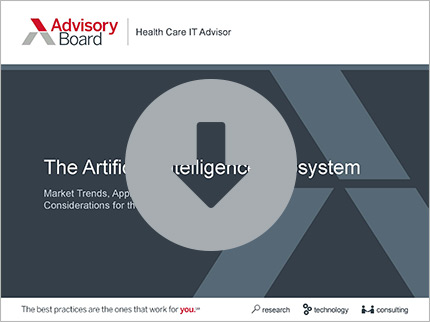Auto logout in seconds.
Continue LogoutRead Advisory Board's take on this story
As artificial intelligence works its way into health care, some wonder whether it can replace the intuition of a human doctor—and a new study from the Massachusetts Institute of Technology (MIT) suggests that it can't, Jeff Lagasse writes for Healthcare Finance.
August 15 webonference: Learn how AI can improve your clinical and financial outcomes
Study details
For the study, researchers wanted to determine whether doctors' "gut feelings" about their patients played a noticeable role in the care provided. To do this, the researchers over a 10-year period analyzed the medical records on 60,000 ICU patients at Beth Israel Deaconess Medical Center, as well as the doctors' written notes on the patient. The researchers analyzed the notes using sentiment analysis, a method based on computer algorithms that analyze written text and track positive and negative words within a text, Lagasse writes.
If doctors' decisions were based exclusively on medical data, then there would be no correlation between the sentiment analysis and the number of tests ordered as reflected in the patient's medical record.
Findings
However, the researchers found that a doctor's intuition helped predict how many tests a doctor would order. This correlation was strongest at the beginning of a patient's hospital stay, when doctors don't have much medical information at their disposal.
In addition, the researchers found that a doctor's outlook on a patient's condition correlated with the number of tests a doctor ordered. When a doctor felt positively about a patient's condition, the doctor ordered fewer tests. In contrast, if the doctor felt pessimistically, the doctor ordered more tests, up to a certain point. According to Healthcare Finance, the study's findings suggest "that human doctors provide a dimension that, as yet, artificial intelligence does not" (Lagasse, Healthcare Finance, 7/26).
Advisory Board's take


Greg Kuhnen, Senior Research Director and Andrew Rebhan, Consultant, Health Care IT Advisor
This MIT study helps to quantify some of the messy reality of clinical decision making, and, in doing so, raises some important points about the strengths and limitations of AI.
While medicine aspires to be a quantified science with precisely documented observations, in reality our data often has blind spots and much of medical practice is still an art. Even the most meticulous documentation must leave out details that play a role in the clinical thought process, and as this research demonstrates, doctors make decisions on more than just the data available in a patient's chart.
Our minds are powerful observation and pattern matching machines, but they have limited attention and suffer from a host of well-known decision making biases. Recent advances in artificial intelligence technologies have made dramatic progress on solving narrowly-focused tasks— predicting sepsis, classifying radiology images, and calculating all kinds of future risks and probabilities. However, progress on broader, more interconnected decision making—often referred to as general intelligence—has been slow.
“Health systems should focus on areas where the strengths of AI can augment human decision making.”
As a result, mature practitioners of artificial intelligence see the technology as an assistant to human intelligence, not a replacement. Health systems should focus on areas where the strengths of AI can augment human decision making by leveraging AI's infinite attention span, its ability to absorb massive amounts of data, its low cost at opportunity to scale, and its calculated focus on getting answers that are accurate—whether or not they're desirable.
It's also important to point out that artificial intelligence technologies are going through a period of rapid advancement. Future systems will not necessarily be limited to the information that fits neatly into a chart, but may be able to rely on reading body language, recognizing speech patterns, and analyzing vast streams of activity and biosensor data to build a more nuanced understanding—far beyond the simplified picture that makes it to the chart.
To learn more about how AI is changing health care—and how your organization can best build a strong AI program, make sure you register today for our upcoming webconferences on August 15th and September 6th.
Register for the Aug. 15 WebconferenceRegister for the Sep. 6 Webconference
Don't miss out on the latest Advisory Board insights
Create your free account to access 1 resource, including the latest research and webinars.
Want access without creating an account?
You have 1 free members-only resource remaining this month.
1 free members-only resources remaining
1 free members-only resources remaining
You've reached your limit of free insights
Become a member to access all of Advisory Board's resources, events, and experts
Never miss out on the latest innovative health care content tailored to you.
Benefits include:
You've reached your limit of free insights
Become a member to access all of Advisory Board's resources, events, and experts
Never miss out on the latest innovative health care content tailored to you.
Benefits include:
This content is available through your Curated Research partnership with Advisory Board. Click on ‘view this resource’ to read the full piece
Email ask@advisory.com to learn more
Click on ‘Become a Member’ to learn about the benefits of a Full-Access partnership with Advisory Board
Never miss out on the latest innovative health care content tailored to you.
Benefits Include:
This is for members only. Learn more.
Click on ‘Become a Member’ to learn about the benefits of a Full-Access partnership with Advisory Board
Never miss out on the latest innovative health care content tailored to you.

